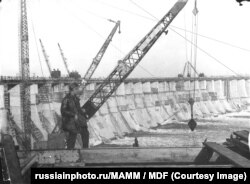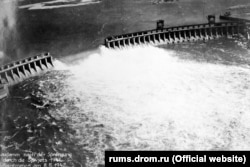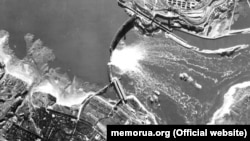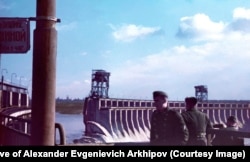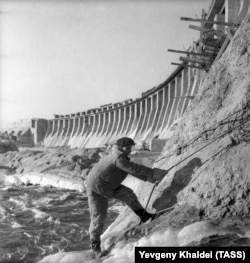The destruction of Ukraine's Nova Khakovka dam on June 6 has unleashed a vast torrent of water into the lowlands of southern Ukraine. While the full toll of the disaster remains unclear, the region has already endured one tragic historical precedent.
In August 1941, with Nazi forces storming toward Zaporizhzhya during the German invasion of the Soviet Union, retreating Red Army forces blasted a hole in the dam of the Dnieper Hydroelectric Station (DniproHES).
The dam is located around 210 kilometers upstream from the location of today's Nova Kakhovka dam.
Mikhail Pervukhin, the official in charge of the Soviet Union's electric power stations at the time, said the 1941 deluge was intended to be weaponized as German forces neared the western bank of the Dnieper River. "The explosion should be organized in such a way as not only to prevent the enemy from moving to the other shore, but also to destroy as much of his equipment and manpower as possible," he wrote in his memoirs.
The explosion reportedly came without people in the floodpath being warned. An eyewitness told Ukrainian media in 2009 that "all night there were cries for help, cows were swimming and mooing and people were climbing trees. There was no one to save people."
Volodymyr Linikov, a historian interviewed by RFE/RL's Ukrainian Service in 2021, said deaths downstream probably numbered in the thousands. He suggested a 1942 German report of around 3,000 people dying in the flood is probably closer to the truth than the "absolute fabrications" of 80,000-100,000 people dying.
The dam's destruction sent shockwaves throughout the U.S.S.R., where the hydroelectric station was seen as one of the jewels in the crown of Soviet heavy industry.
An American journalist, conflating ethnic Russians with Soviets, wrote in 1941 that "the Russians have proved now by their destruction of the great dam at Dnipropetrovsk that they mean truly to scorch the earth before Hitler even if it means the destruction of their most precious possessions."
He added that "Stalin's order to destroy it meant more to the Russians emotionally than it would mean to us for Roosevelt to order the destruction of the Panama Canal."
Occupying Germans partially restored the power station, but in 1943 the tide of the war turned and Nazi forces in turn blasted the dam in an attempt to stall the Soviet advance.
The dam was fully repaired by 1950. Today the DniproHES is in use under private ownership.
